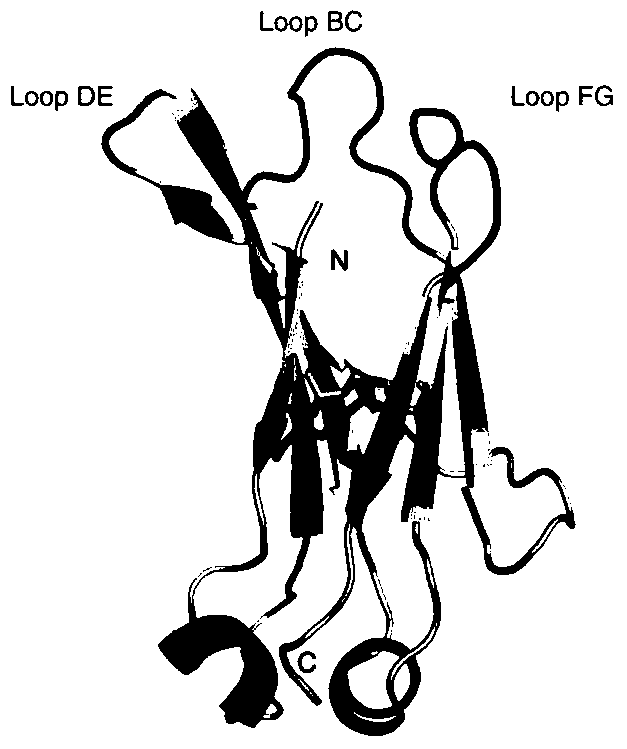A nanobody that neutralizes Ebola virus
An Ebola virus and nanobody technology, applied in nanotechnology, antibodies, antiviral agents, etc. for materials and surface science, can solve the problems of high production cost and low expression, and achieve low production cost and cycle time. Short, good tissue penetration effect
- Summary
- Abstract
- Description
- Claims
- Application Information
AI Technical Summary
Problems solved by technology
Method used
Image
Examples
Embodiment 1
[0041] [Example 1] Expression and purification of Ebola virus envelope protein
[0042] According to the gene sequence of Ebola virus (GenBank No.AY354458), its amino acid sequence was analyzed, and the gene Gp499 of the extracellular domain (amino acid 33-311, 463-632) of its envelope protein was synthesized, and the gene was connected with the vector pSecTag2A, transformed, and constructed Vector pSecTag2A-Gp449. 1 day before transfection, 293F cells (control cell density was 5-×10 5 cells / ml) 40mL was inoculated in a 125mL suspension cell culture flask. Dilute 40 μg of the plasmid (pSecTag2A-Gp449) in 4 mL of medium and mix gently, then dilute 120 μL of PEI (polyethyleneimine) in the culture medium and mix gently. They were added dropwise to the cells after 20 min incubation at room temperature. The cells were placed in a suspension incubator at 250 rpm at 37°C for suspension culture.
[0043] After 144 hours, the culture supernatant was collected, and the envelope prot...
Embodiment 2
[0045] [Example 2] Construction of phage display library for screening
[0046] Using m01s as the backbone, a phage library was constructed according to existing literature (Gong R, et al., PLoS ONE, 2012), and screened with antigens expressed by mammalian cells. After the purified antigen was incubated overnight at 4°C in a 96-well plate, panned with a phage library, the specific phage was captured by the antigen, washed with PBS+0.05% Tween-20, and after 7 rounds of screening, a The enriched clone was named ebo7. Using ebo7 as the backbone, the gene sequence was randomly mutated, and a specific high-affinity clone was obtained from the mutant, which was named ebo7c2.
Embodiment 3
[0047] [Example 3] Expression and purification of ebo7c2
[0048] The ebo7c2 was expressed and purified according to the existing literature (Gong R, et al., Methods Mol Biol., 2012). The prokaryotic ebo7c2 expression vector was constructed and transformed into E.coli HB2151. Re-inoculate the strains in SB medium containing 100 μg / ml ampicillin (1L medium contains 30g tryptone, 20g yeast extract and 10g MOPS, the pH value is adjusted to 7.0 with NaOH), and the OD 600 When it reaches 0.7-1.0, add IPTG to a final concentration of 200 μg / ml, and induce expression at 37° C. and 220 rpm for 14-16 hours. Collect the bacteria by centrifugation at 4°C, 6000rpm, 15min, discard the medium, resuspend the pellet in Buffer A (50mM Tris-HCL, 450mM NaCL, pH 8.0), treat with polymyxin B (polymyxin B) for 1 hour and then centrifuge Collect the supernatant. Purified with Ni-NTA filler and verified its purity by SDS-PAGE. Then it was concentrated by ultrafiltration with an ultrafiltration ce...
PUM
 Login to View More
Login to View More Abstract
Description
Claims
Application Information
 Login to View More
Login to View More - R&D
- Intellectual Property
- Life Sciences
- Materials
- Tech Scout
- Unparalleled Data Quality
- Higher Quality Content
- 60% Fewer Hallucinations
Browse by: Latest US Patents, China's latest patents, Technical Efficacy Thesaurus, Application Domain, Technology Topic, Popular Technical Reports.
© 2025 PatSnap. All rights reserved.Legal|Privacy policy|Modern Slavery Act Transparency Statement|Sitemap|About US| Contact US: help@patsnap.com



